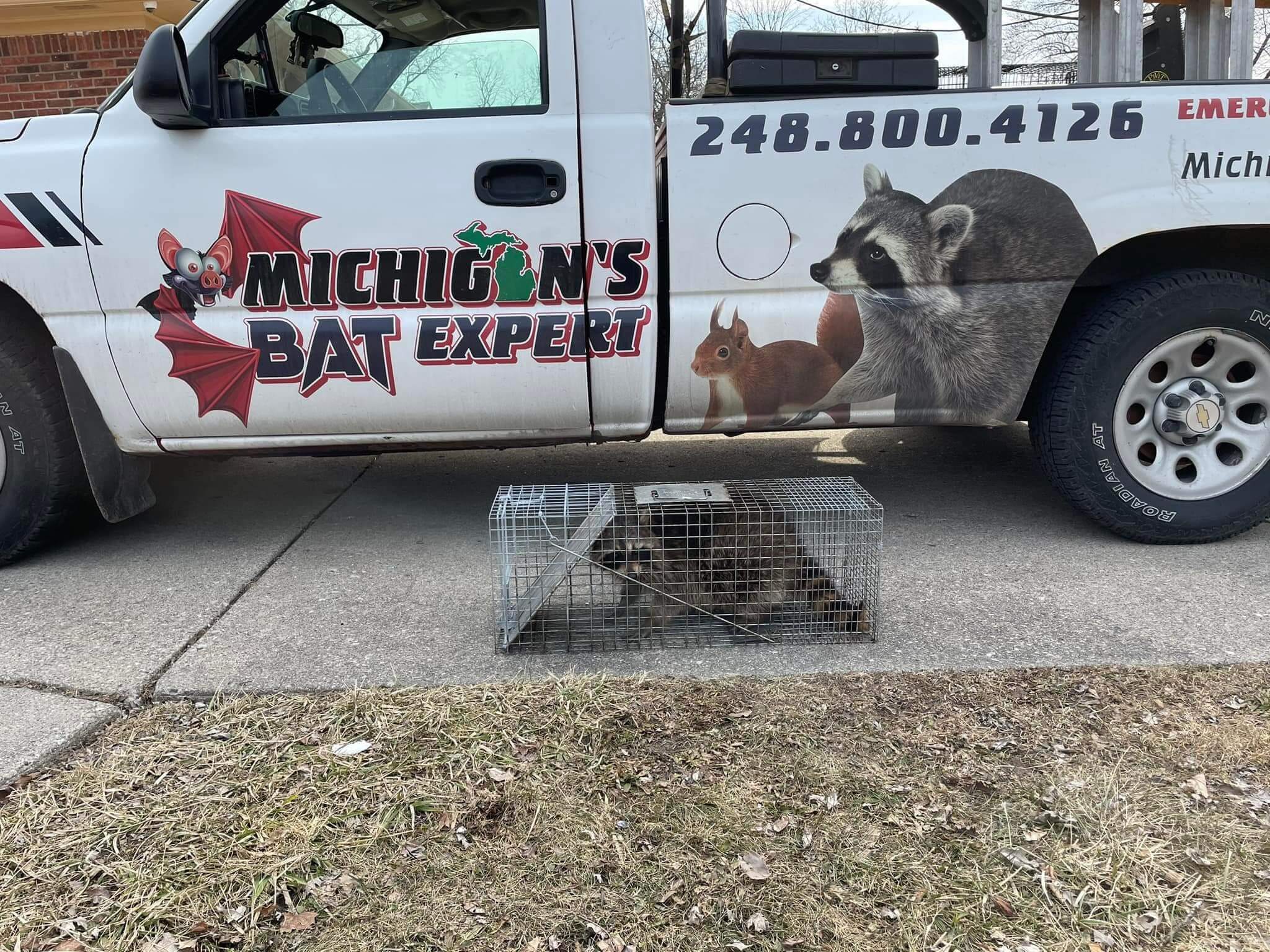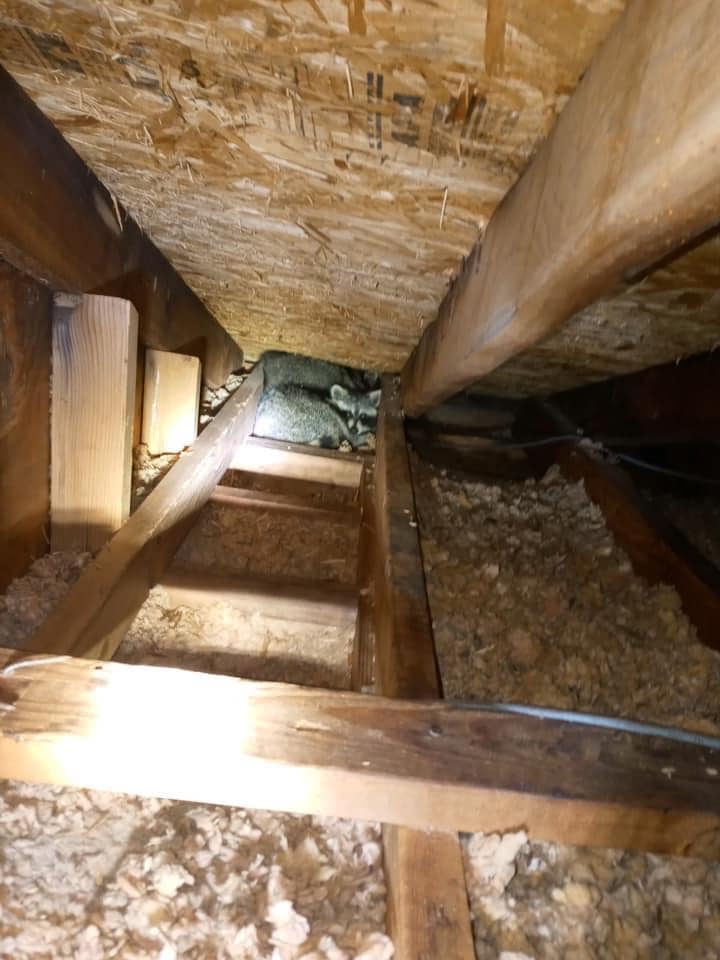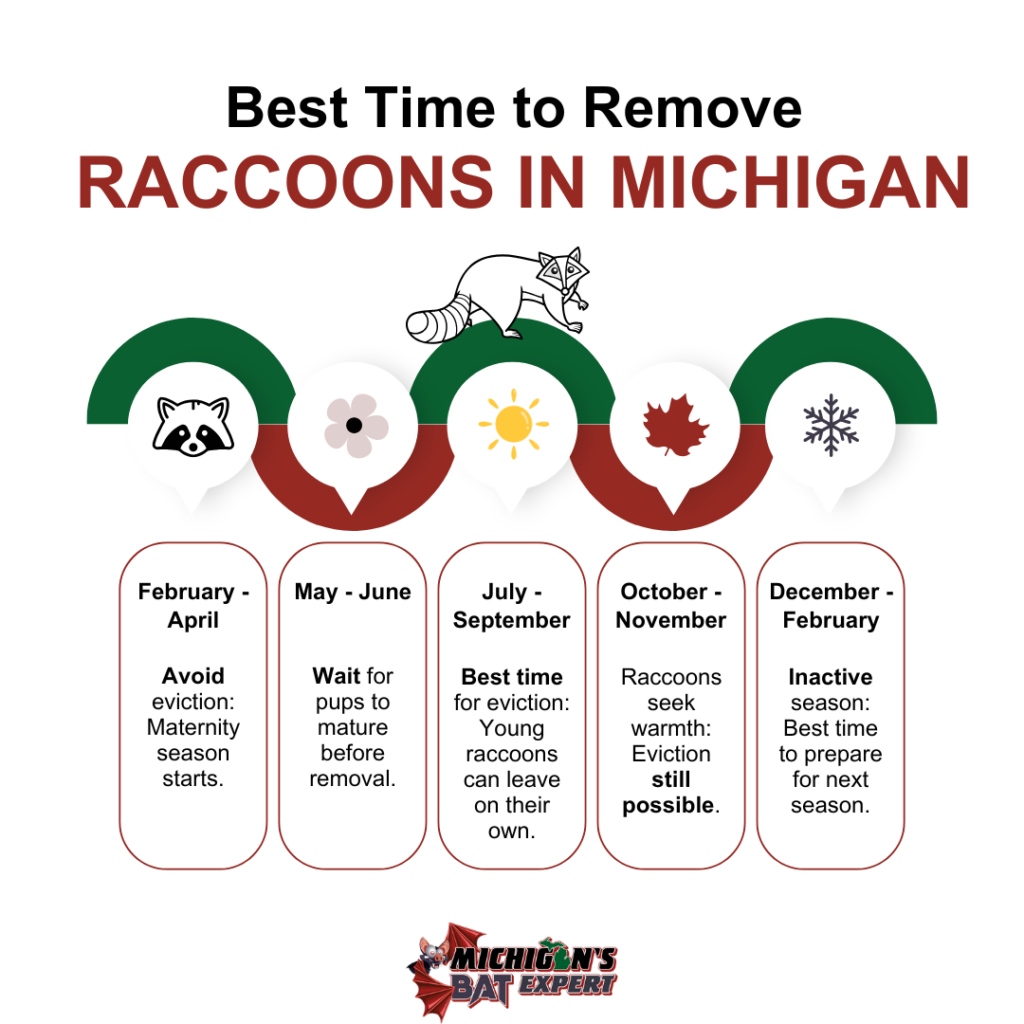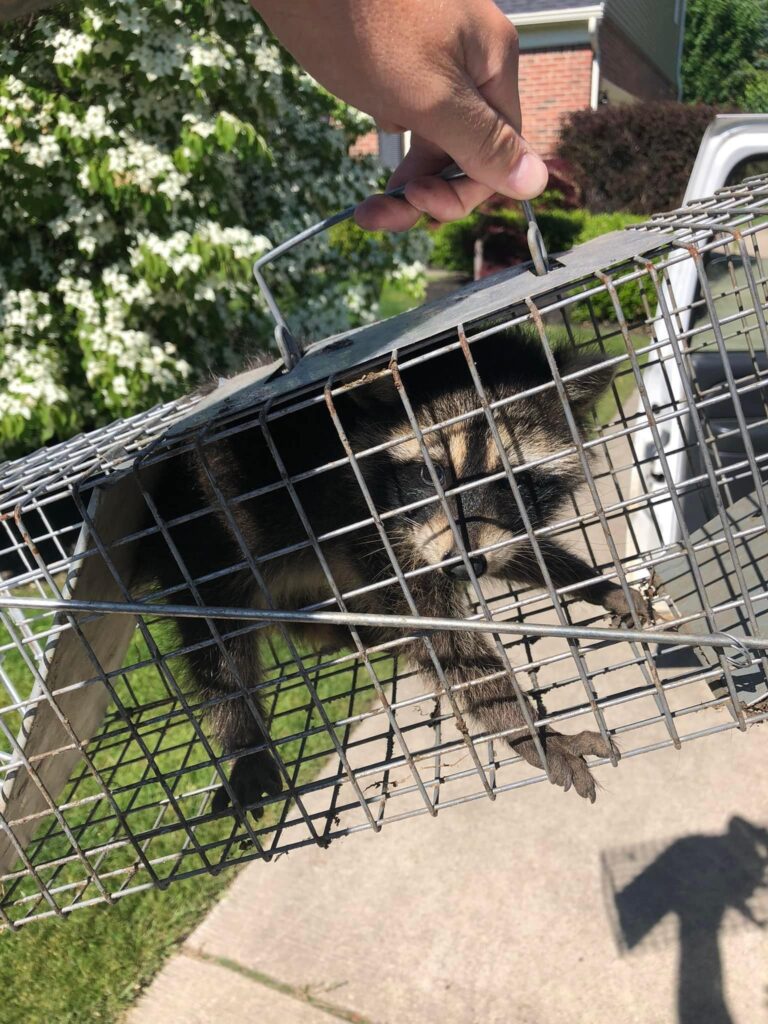
It’s a cold winter night in Michigan. You’re sitting in your living room, the house is quiet… until you hear it. A scratching sound. A little bumping. And then… more scratching. It’s coming from above. Is it just the house settling? Or is something more serious happening—like a raccoon problem?
As you lie there listening, the noise gets louder, and suddenly, you realize: “Oh no, could it be a raccoon in the attic?”
Dealing with a raccoon problem in your attic, chimney, or anywhere else in your home is no small matter. But don’t worry, with the right timing and a little help from the experts, handling a raccoon infestation doesn’t have to be stressful. In fact, it can be a straightforward process that ensures the safety of your home, your family, and the raccoons involved.
Let’s walk through the essential tips to safely remove raccoons from your Michigan home.
Why Raccoon Problems Are Common in Michigan Homes
Michigan winters can be harsh, and when temperatures drop, you’re not the only one looking for warmth. Raccoons are no strangers to the cold—they’re always in search of a safe, warm place. Your attic, chimney, or crawl space might just be the perfect refuge for these crafty creatures.
As the days get shorter and the weather turns colder, raccoons become more active in their search for shelter. They’re expert climbers and won’t hesitate to find small openings—whether it’s a crack in the roof, a loose vent cover, or a gap around the chimney. This makes homes, especially older ones, prime targets. In Michigan, raccoons are known to nest in homes during the winter months, taking advantage of these openings to find a safe place to rest.
Signs of a Raccoon Infestation in Your Home
Now that you know what to look out for, let’s get into the specifics. If you’ve been hearing strange noises at night or noticed unusual damage around your home, it’s important to understand the signs that you’re dealing with a raccoon infestation. Raccoons are nocturnal, sneaky creatures that often move around at night, so it’s easy to miss the early warning signs. Recognizing these signs early can save you a lot of trouble and expense.
1. Scratching, rustling, or thumping noises in the attic
If you hear scratching or rustling noises coming from your attic or walls, it’s a strong indication that raccoons have made themselves at home. Raccoons are excellent climbers and often choose attics, chimneys, or crawlspaces as their nesting sites. These noises usually happen at night when raccoons are most active, foraging for food or making their nests.
What should you do?
- Don’t ignore it: If you’re hearing these noises, don’t wait too long before inspecting your home. The longer you wait, the more damage they can cause.
- Check for other signs: Look for raccoon droppings or damaged insulation, which could be a result of the raccoons tearing up the attic.
2. Raccoon tracks or droppings
Raccoons often leave clear signs of their presence. Look for tracks around your roofline, vents, or attic entrance—these are common areas where raccoons might travel. Raccoon droppings are another key indicator, often found in places where they’ve been nesting or foraging.
One of the easiest ways to identify a raccoon infestation is by finding these traces. If you notice tracks or droppings, it’s a strong sign that raccoons have made their way into your home.
What should you do?
- Inspect key areas: Check around your roof, attic, or any other potential entry points for tracks or droppings.
- Take photos: If you find evidence, take photos and note the areas where you’ve seen the signs. This will help when a professional comes to inspect your home.
3. Damaged insulation and chewed wires
Once inside, raccoons will make their nest in the insulation, tearing it up to create a warm, safe spot for their young. Not only does this damage the insulation, but it also makes your home more vulnerable to pests and temperature fluctuations.
What should you do?
- Immediately stop using the affected areas: If you suspect damage to your insulation or wiring, contact a professional to inspect and make repairs immediately.
- Don’t try to fix it yourself: Raccoon removal and repair of wiring should only be done by licensed professionals to avoid safety risks.
4. Visible entry points
Raccoons can fit through surprisingly small gaps. Check around your home for potential entry points—loose roof shingles, broken vents, or gaps around chimneys are common culprits. Raccoons may also use tree branches to climb to your roof and enter through an attic vent.
What should you do?
- Inspect your home: Look for any holes, cracks, or gaps in your attic, roofline, or chimney. Ensure that all vents are properly sealed.
- Consider preventive measures: Install mesh around vents and secure roofline gaps to prevent raccoons from entering.

The Best Time to Remove Raccoons in Michigan
As winter turns to spring, raccoons are especially active. From February to May, female raccoons are typically looking for a safe place to give birth. And guess where that safe place often ends up being? That’s right—your home.
But here’s the thing: it’s critical to wait for the right moment before removing them. Here’s why:
- Maternity season: Female raccoons give birth to their pups during this period, and eviction can result in separating the mother from her young. This can harm the pups, and it’s illegal under Michigan’s wildlife protection laws. The Michigan DNR recommends waiting until after maternity season, around June to September, when the pups are strong enough to leave the nest.
- Property damage: During spring, raccoons will start nesting and may cause major damage to your home. Rooflines, insulation, wiring—you name it. If you act too late, you could be looking at costly repairs.
- Legal concerns: Raccoons are protected in Michigan, and eviction must follow humane practices to avoid violating wildlife protection laws. Michigan’s DNR recommends adhering to proper legal procedures to avoid fines or further complications.
For a safe and humane eviction, it’s best to act before or after maternity season—typically around June to September, when the young raccoons are capable of leaving the roost on their own.

Safe and Humane Raccoon Removal Methods
Once you know the timing, here’s how the pros get the job done safely and humanely. And while some homeowners may be able to handle the process on their own, it’s important to keep in mind that raccoon removal is best done with care and proper knowledge. Inexperienced handling can lead to injury or further damage to your home.
- Inspection: Professionals will inspect your home thoroughly, looking for entry points and assessing the damage. They’ll know exactly where to look based on the raccoons’ habits.
- Humane trapping: If necessary, professionals use humane traps to capture the raccoons without harm. This process ensures no animals are injured during the eviction.
- Exclusion devices: One-way exclusion devices are installed to allow raccoons to leave your home but prevent them from re-entering. These devices are best installed just before dusk, when raccoons are most active.
- Sealing entry points: Once the raccoons have been safely removed, all potential entry points are sealed to prevent future access. This step is vital to avoid another infestation.
- Clean-up and sanitation: Raccoons leave behind droppings, urine, and other debris that can spread diseases. Attic restoration services help sanitize affected areas and keep your family safe from potential health risks.
It’s important to remember: Handling raccoon removal safely is all about doing things the right way. With the right approach, you’ll have peace of mind knowing that everything is done properly to prevent a future problem.

The Risks of Delaying Raccoon Removal
We understand that handling a raccoon infestation might seem like a hassle, but delaying the removal can have serious consequences:
- Property damage: Raccoons can cause significant damage to your home. They will tear up insulation, chew on wires, and damage structural components as they nest.
- Health risks: Raccoons are known to carry diseases like rabies, leptospirosis, and salmonella. If you come into contact with their waste or even their saliva, it could put you and your pets at risk.
- Legal issues: In Michigan, it’s illegal to remove raccoons during maternity season if it involves separating mothers from their pups. Failing to comply with these laws could result in fines and legal complications.
So, the best advice? Don’t wait too long to deal with the situation. The sooner you act, the better the outcome—for your home, your family, and even the raccoons.
Schedule Your Professional Raccoon Eviction Today
Raccoon problems are best addressed early to avoid damage and health risks. If you’re experiencing raccoon-related issues in your home, don’t wait—contact Michigan’s Bat Expert for a thorough inspection and safe, legal removal. Our professional team is ready to help, ensuring your home stays raccoon-free.
Call us today at (248) 923-4762—24/7 Emergency Service Available.
Explore More Wildlife Removal Solutions for Your Michigan Home
If you’re facing challenges with other wildlife issues such as bats, skunks, or squirrels, we’ve got you covered! Take a look at our comprehensive blog posts to discover expert tips and actionable advice on safe removal of bats and humane trapping methods. From common household pests to larger wildlife problems, our team is here to guide you every step of the way in protecting your home and keeping your family safe.

Sam Sullivan is the owner and lead expert at Michigan’s Bat Expert, specializing in humane bat removal and exclusion services based in Oakland County, Michigan. With years of hands-on experience in wildlife control, Sam has helped countless homeowners and businesses protect their properties from bat and wildlife infestations while adhering to Michigan’s strict wildlife laws.
His expertise lies in exclusion and prevention, ensuring that bats and wildlife are removed safely and never return. Sam is dedicated to ethical and effective solutions, using proven methods that prioritize both property protection and wildlife conservation. His commitment to excellence has made Michigan’s Bat Expert a trusted name in the industry.


